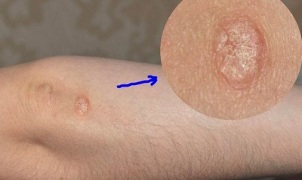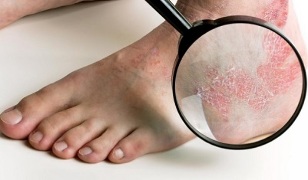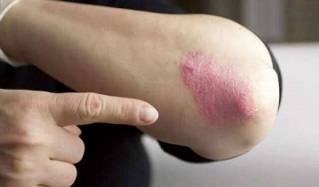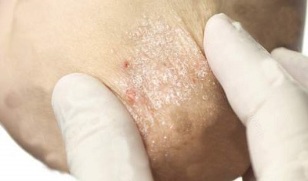Psoriasis is an inflammatory skin disease. Occurs when the immune system malfunctions. The development of the disease is divided into clear stages - emergence, progression, stability and regression. The different stages of psoriasis differ in the appearance of spots and rashes, painful itching and extensive dermatitis.
Why is it necessary to differentiate the developmental stages of the disease, what are the manifestations of psoriasis in the early stages of development and recovery?
Why you need to know the stages of psoriasis

The division of psoriasis into stages is used by doctors to select the correct treatment. A complex of drugs and external agents that are indicated for the treatment of inflammation depends on the stage of the disease's development.
At the onset of the disease, general treatment is needed - vitamin complex, diet, aseptic treatment outside the rash, for example, a UV course. Also prescribed drugs that stimulate cleansing of the intestines, blood vessels, liver.
Guaranteed correction of psychological state - by a neuroscientist or psychologist.
In the early stages of the disease, they do not use strong drugs that can suppress the immune system, do not prescribe hormonal ointments. These drugs have a large list of side effects, so they are prescribed only when it is impossible to take without them.
Psoriasis: treatment in the acute phase and remission
In the case of an acute progressive disease, a number of drugs with different effects are prescribed. Immunosuppressants and glucocorticosteroids are often used to reduce inflammation and itching. External treatments are complemented by photochemistry, ultrasound and laser therapy. In addition, substances are prescribed for disinfection of the treatment of damaged skin.
In steady state, they continued to take anti-inflammatory hormonal drugs, gradually decreasing the dosage. For the restoration of damaged skin, a regenerating ointment is prescribed.
Remission - support of the body. Proper nutrition, take vitamin and mineral complexes to restore immunity.
Promptly treat
The earlier you start treatment, the easier it is to control psoriasis.

Timely treatment limits the spread of dermatitis, reducing its level, preventing recurrence of subsequent flaking. Since psoriasis is often mistaken for an early allergic rash, it is important to know its early signs so as not to miss the manifestation of a skin disease.
Note:doctors are still investigating the cause of psoriasis. But everyone knows that psoriatic dermatitis is not contagious. It cannot be picked up from the sick person, or infected in the event of an injury. This is our own failure, the individual in the human body.
The cause of psoriasis is impaired immunity, which can be caused by a variety of factors. Severe stress, poisoning (including strong drugs, industrial emissions, alcohol), previous infection.
Psoriasis is very difficult to treat. The disease is easy to recur, recurrence. And therapy itself is the symptom. It includes preventing the appearance of new spots and relieving existing skin itching.
What stage of psoriasis is called initial? How to distinguish early psoriasis from a visceral rash? And how will the disease develop in the future?
Psoriasis: early stage
The first appearance of psoriasis on the skin looks like a pimple. Usually, the rash appears at the bends of the elbows and knees, or where the clothing is pressed tightly against the body (for example, under the belt at the waist). The rash can also appear along the hairline and under the hair, around the nails and on nail plates. Psoriasis sometimes occurs on the feet and palms.
Psoriasis almost always manifests symmetrically - on the elbows of both hands, or on both sides of the lower back or above the knees.
Pimples themselves (in medical terms - papules) in the early stages have a humble appearance. They have:
- Pink or red;
- Sharp, matte edges;
- Small size - acne at the base of no more than two mm;
- Flat shape - small, dot-like bumps in the early stages of the disease have almost no blisters, so they look like spots.
As the disease progresses, flaky patches of skin appear on the pimples. They are gray or silver in color, on a red background they appear white.
Scaly appearance with severe itching. If you do not resist and scratch, the scabs will peel off, revealing areas of shiny young skin underneath. It is very thin, susceptible to damage, when prolonged scratching itchy papules - it is injured, bleeding.
The initial stage of psoriasis lasts up to four weeks.
Psoriasis: advanced stage

During the progression, individual blemishes merge into one thing, forming the so-called psoriatic plaque. They protrude on the surface of the skin and are almost completely flaky. At the edges of the psoriatic plaques have a red, non-flaky red border.
The presence of the earcup is a sign of a progressive stage of the disease. The rim is one to two mm wide. The skin on it is inflamed and has a parchment-like structure.
The rim represents the enlarged area of the point. This is an area of skin that is inflamed but not flaky. After a while, it will also become scaly. And the patch will expand to cover new areas of skin and form a new, wider rim.
With the active development of the disease, the adjacent spots fuse together. At some point, a large, inflamed red spot may form on the human body.
Scaly patches are very itchy, causing discomfort for the sick person, interrupting work, rest and sleep. They grow, occupy a large area and form a new rash on clean, healthy skin.
The main sign of progression is the appearance of new rash. As soon as the pimples and pimples stop appearing, the next stage of psoriasis begins - stillness. This is not yet a complete victory, but it is already a step toward recovery.
During the progressive stage psoriasis is almost always accompanied by weakness, fatigue, and weakness. Depression is common. Possible temperature.
Note:some medical theories say the opposite. Depression is not a consequence of psoriasis. And psoriasis is a consequence of neurological, psychiatric depression.
The advanced stage of psoriasis can last up to several months.
Psoriasis: a stationary phase

The main sign of the sedentary phase is the cessation of the appearance of new spots and rashes. At the same time, the itchiness is weaker and more uncomfortable. The rash is bright discolored, discolored, not visible. This is also one of the signs that the movement is stabilizing.
The pink borders around the plaques disappear once the inflammation stops spreading. Activates exfoliation and healing activities, and renews healthy skin.
It can be seen with the naked eye that peeling increases in the stationary stage. The scales completely cover the entire surface of the psoriasis, leaving no space for the rim.
Typical scaly psoriasis is commonly recognized by the general public. Large-scale flaking in the stage of static is not dangerous.
When all the dead cells are peeling off the surface of the psoriasis, healthy skin with a light shine will remain in their correct position.
Other signs of progression or stability
In addition to the appearance of hives, spots, and scabs, there are a number of other signs that can be used to judge the development of the disease. This is the nature of the itchy sensations (strong or tolerable), the general condition, the depressed mood. And temperature is present.
In the early stages, the itching may change and the rash cannot be understood. What's more, the itch gets worse every day. During the acute phase of psoriasis, it becomes intolerable. Interrupting sleep, resting, interfering with work. The person becomes irritable because the itchy sensation does not give him a chance to rest.
During a period of calm, the itching subside. Every day - one person feels better. The general state of psychology changes, negative moods and depression weaken. The duration of the static phase is several weeks - from 2 to 5.
Psoriasis in a descending stage

The fading stage of psoriasis is the almost complete disappearance of plaques, spots, redness, inflammation, itching.
At this stage of the disease, psoriasis is only reminiscent of different skin pigmentation. Instead of the previous psoriasis, it looks lighter. The surface of healthy skin has a darker color.
In some cases, so-called hyperpigmentation is formed. The skin at the site of the psoriasis does not become brighter, but it is also darker. In any case, the difference in skin pigmentation should be visible within one to two months.
Psoriasis after recovery: possibility of recurrence
The likelihood of psoriasis recurrence is determined by the person's lifestyle, diet, allergic mood, the state of the body in general. It is also determined by the amount of toxins in his body, blood, and liver. You can minimize the chance of getting repeated dermatitis if you strengthen your immune system and clear your body from toxins in the liver, blood vessels, and intestines.
Seasonal recurrences of psoriasis are usually rarely after cleansing. A person is still susceptible to getting sick, but the likelihood of it happening is greatly reduced.
Purifies the body to flush toxins and adds complex vitamins and minerals to boost immunity. This is especially important if immunosuppressants are used during treatment, during the advanced phase of psoriasis. Their need is due to the work of inflammatory mediators. After suppressing autoimmune defenses, it is necessary to restore the immune system.























